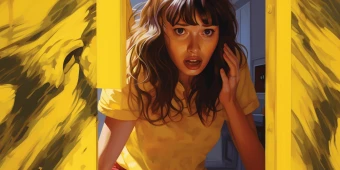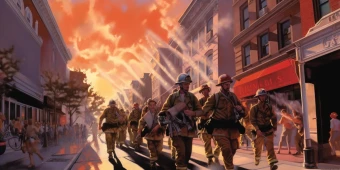by Franz Kafka


The Metamorphosis Symbolism
Table of contents
- The Picture of the Woman in Furs
- The Father's Uniform
- Grete's Violin
- Food
- The Door
The Picture of the Woman in Furs
In "The Metamorphosis," the picture of the woman in furs is a recurring symbol that represents Gregor Samsa's desire for freedom and his alienation from the world. The painting hangs in Gregor's bedroom and captures his attention throughout the story. At first, the woman in the painting is a comforting presence for Gregor, and he finds solace in her beautiful and luxurious appearance. However, as Gregor's transformation progresses and his isolation intensifies, the woman in the painting takes on a more ominous and oppressive quality.
The woman in furs can be seen as a representation of the idealized version of life that Gregor desires but can never attain. The luxurious and glamorous nature of the woman in the painting stands in stark contrast to the drab and monotonous existence that Gregor experiences. The painting becomes a source of comfort for Gregor in his moments of despair, but ultimately serves as a reminder of his inability to experience the pleasures of life.
As the story progresses, the woman in furs takes on a more sinister role. Her presence becomes oppressive and stifling, mirroring Gregor's own feelings of entrapment and confinement. Gregor begins to feel that the woman in the painting is staring at him and judging him, representing the societal expectations and pressures that he is unable to live up to. The painting serves as a reminder of the expectations that Gregor's family and society have for him and the ways in which he is failing to meet them.
In the end, the woman in furs becomes a symbol of Gregor's longing for release from his confinement. When his family finally decides to remove the painting from his room, Gregor experiences a sense of relief and a moment of clarity. The removal of the painting represents the possibility of freedom and escape from the confines of his former life.
Overall, the picture of the woman in furs is one of the powerful symbols in "The Metamorphosis," representing both Gregor's desire for freedom and his entrapment in a world that does not understand or accept him. The painting serves as a reminder of the unattainable pleasures of life and the societal pressures that can lead to isolation and alienation.
The Father's Uniform
The father's uniform is one of the important symbols in The Metamorphosis by Franz Kafka, as it represents Gregor's loss of power and authority within the family. Throughout the story, Gregor feels a deep sense of shame about his transformation and inability to provide for his family. He feels emasculated and helpless, unable to fulfill his responsibilities as the breadwinner of the family. This is particularly evident when he sees his father donning his uniform, which is symbolic of his authority and power as the head of the household.
In contrast, Gregor is now powerless and dependent on his family, and the uniform serves as a stark reminder of this. When Gregor sees his father in the uniform, he feels a sense of fear and oppression, realizing that he can no longer assert his own authority within the family. This symbolizes the shifting power dynamics within the family, with Gregor's father assuming the role of provider and protector, while Gregor becomes a burden.
Moreover, the uniform is also symbolic of the father's desire for respect and social status. He takes great pride in his appearance, and the uniform represents his position of authority within his profession. This desire for status and respect is also reflected in the way he treats Gregor, dismissing him as a useless and burdensome insect rather than acknowledging his humanity and worth.
In conclusion, the father's uniform symbolizes the power dynamics within the family, as well as the father's desire for social status and respect. It highlights Gregor's loss of authority and power, and his sense of shame and helplessness. It also underscores the lack of empathy and understanding within the family, as they fail to recognize Gregor's humanity and worth.
Grete's Violin
In "The Metamorphosis," Grete's violin serves as a powerful symbol of the deteriorating relationship between Gregor and his family. At the beginning of the story, Gregor is a hardworking salesman who sacrifices his own happiness for the sake of his family. He wakes up one day to find himself transformed into an insect and becomes a burden to his family. As the story progresses, Gregor's family begins to resent him and view him as an obstacle to their own happiness.
Grete's violin symbolizes the emotional connection that the family once had. Gregor had always been supportive of Grete's musical talents and even helped pay for her lessons. However, as Gregor's transformation progresses, the family becomes increasingly preoccupied with their own desires and interests. They begin to neglect Gregor, and Grete even suggests that they should get rid of him. When Gregor hears Grete playing the violin, he is moved by the beauty of the music and feels a momentary sense of connection with his sister.
However, this connection is short-lived, as Grete soon grows tired of taking care of Gregor and becomes increasingly hostile towards him. She eventually breaks the violin out of frustration and anger, symbolizing the breakdown of the family's emotional bond. The violin's destruction marks a turning point in the story, as it is the moment when Gregor realizes that he is no longer welcome in his own home.
Overall, the violin symbolizes the family's emotional connection and highlights the tragedy of their breakdown. The destruction of the violin marks a significant moment in the story, as it represents the family's rejection of Gregor and the loss of their emotional bond.
Food
In Franz Kafka's The Metamorphosis, food plays a significant role in conveying the themes of isolation and dehumanization. As Gregor's transformation progresses, he finds himself less able to tolerate human food and begins to prefer rotten, decaying items.
The use of food symbolism in The Metamorphosis reflects the way Gregor's relationship with his family has deteriorated. At the beginning of the story, Gregor is the breadwinner for his family, working as a traveling salesman to support them. However, after his transformation, he becomes isolated and no longer able to fulfill this role. His rejection of human food represents a rejection of his former identity and his inability to connect with his family on a human level.
Furthermore, the family's reaction to Gregor's food preferences reveals their own dehumanization. They begin to view him solely as a burden and a source of disgust, rather than as their son and brother. When they attempt to clean his room and dispose of the rotten food, it becomes clear that they no longer see him as a human being.
The symbolism of food in "The Metamorphosis" extends beyond Gregor's transformation. In the final scene, when the family is eating a meal together, food is used to convey their emotional distance and lack of connection. The food itself is described as tasteless and unappetizing, mirroring the emotional emptiness of the family's relationship.
In this way, the symbolism of food in "The Metamorphosis" highlights the dehumanization and emotional distance between the characters. It serves as a reminder that, despite their physical presence in the same space, they are unable to connect on a meaningful level.
The Door
In "The Metamorphosis," the door symbolizes the boundary between the outside world and the private world of the Samsa family. It represents Gregor's inability to leave his room and participate in the outside world. After his transformation, Gregor's family isolates him in his room, and the door becomes a physical barrier between him and the rest of the house.
At the beginning of the novella, the door also symbolizes Gregor's desire to leave his job and the burden of supporting his family. He feels trapped in his job, and the thought of his father's debts and the pressure to support his family weigh heavily on him. When he wakes up transformed into an insect, he initially feels free from these responsibilities, but quickly realizes that he is now a burden on his family and unable to support them.
As the novella progresses, the door symbolizes Gregor's deteriorating relationship with his family. His family members begin to view him as a monster and are repulsed by his appearance. They avoid him and refuse to open the door, even to bring him food. The door becomes a barrier between Gregor and the love and support of his family.
Finally, the door symbolizes Gregor's impending death. He realizes that he is a burden on his family and that they would be better off without him. He longs to be free from his insect body and the isolation of his room. When he dies, his family finally opens the door and sees his body for the first time, symbolizing the end of his suffering and the beginning of their mourning and acceptance of his death.

- Instructions Followed To The Letter
- Deadlines Met At Every Stage
- Unique And Plagiarism Free


 The Yellow Wallpaper
The Yellow Wallpaper
 The Great Gatsby
The Great Gatsby
 The Things They Carried
The Things They Carried